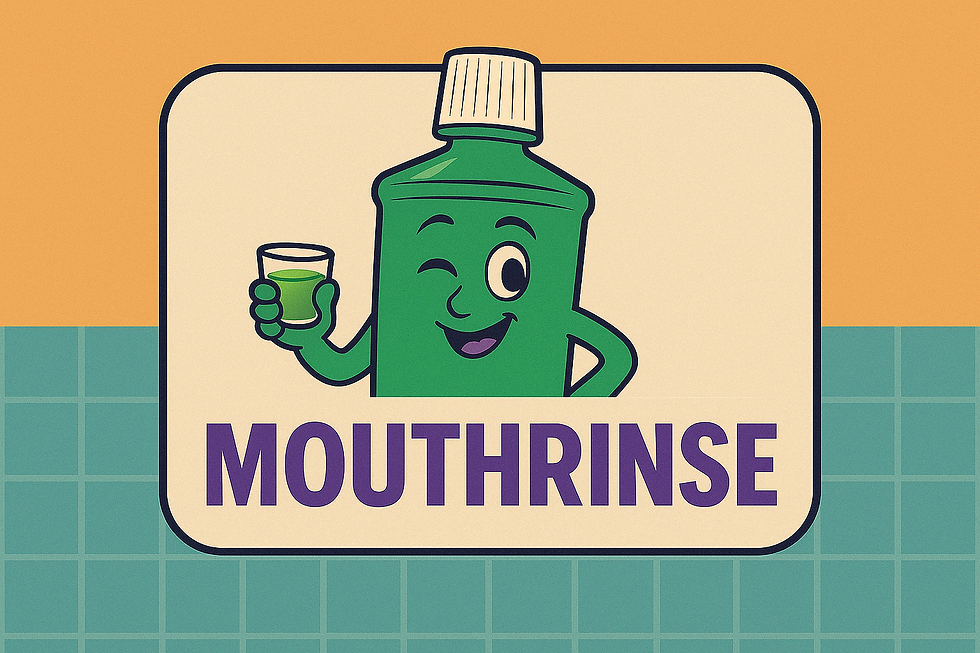Waterpik
- naytoghlo
- Apr 21
- 4 min read
Updated: Apr 23

Hello again, Smile Superstars! Dr. Noor here.
We've talked about our toothbrush hero Brenda, the splashy fun of Mouthrinse, and the interdental investigations of Flossie. But today, let's meet another player in the oral hygiene game – the one that sounds like it's preparing for liftoff: the Water Flosser, often known by the popular brand name, Waterpik!

Imagine a tiny, super-targeted pressure washer designed specifically for your mouth. Instead of string, this gadget uses a pulsating stream of water to blast away food particles and plaque hiding between your teeth and along your gumline. It really does feel like a refreshing spa day for your gums, giving them a little massage while evicting unwanted debris. Wheee, indeed!
So, Who Needs This Water Warrior? (And Does it Actually Work?)
While traditional floss (like our friend Flossie) is fantastic at mechanically scraping away sticky plaque, a water flosser brings its own unique superpowers. And importantly, scientific research backs up its effectiveness.
Clinical studies have consistently shown that water flossers can be highly effective tools for improving oral health. For instance, research published in journals like the Journal of Clinical Dentistry has demonstrated that using a water flosser in addition to manual brushing can significantly reduce gingivitis (gum inflammation and bleeding) and plaque biofilm compared to traditional string flossing plus manual brushing.
So, that "spa day" feeling isn't just pleasant – the hydrokinetic activity (that pulsating water stream!) is actively disrupting bacteria and flushing debris, even from below the gumline where brushes and sometimes even floss struggle to reach effectively.
This makes it particularly amazing for:
Brace Brigades & Implant/Bridge Crews: Got hardware? Navigating floss around brackets, wires, implants, or under bridges can feel like performing dental gymnastics. A water flosser easily jets water into those tricky spots, and research supports its effectiveness in these populations.
Those Who Find Flossing Fiddly: If dexterity issues (like arthritis) make handling string floss difficult, or if you really just can't get the hang of traditional floss (we talked about the "floss laziness" in my confession blog, remember?), a water flosser provides a proven effective alternative for cleaning between teeth.
Gum Health Guardians: The pulsating action stimulates your gums, and as mentioned, it's scientifically shown to be great at flushing out bacteria and reducing inflammation in periodontal pockets (those spaces between your tooth and gum). If gum health is a particular focus for you, this is a research-backed tool to consider.
Anyone Who Loves That Super-Clean Feeling: That refreshing blast isn't just perception – it's contributing to a measurable reduction in harmful plaque and inflammation.
Water Flosser Wisdom: Things to Keep in Mind
Different Action, Proven Results: While the mechanism is different from the scraping action of string floss (it's more about flushing and pulsation), clinical studies confirm its effectiveness in reducing plaque and gingivitis, often even more effectively than string floss when added to brushing.

The Splash Zone: There can be a learning curve! Until you get the hang of leaning over the sink and keeping your lips slightly closed to let the water drain, you might accidentally give your bathroom mirror a rinse too. Start on a low setting!
It's an Addition or Alternative: Think of it as another powerful, evidence-based tool. It doesn't necessarily replace floss for everyone (some people prefer the tactile feel of floss or use both), but it's an excellent additionor a primary interdental cleaner, especially given the strong research supporting its benefits over traditional methods for many people.
How to Wield the Water Wand:
Fill 'er Up: Use lukewarm water (unless you enjoy a chilly surprise!).
Lean In: Lean over your sink to avoid redecorating your bathroom.
Aim Low (Pressure): Start with the lowest pressure setting and gradually increase as you get comfortable.
Trace the Gumline: Aim the tip at your gumline at a 90-degree angle.
Pause and Proceed: Briefly pause in the space between each tooth, letting the water flush the area, then move along the gumline to the next space. Work your way around both upper and lower arches, inside and out.
The Verdict: To Jet Stream or Not?
A water flosser isn't just a gadget; it's a clinically proven tool for improving oral hygiene. Many people find it makes cleaning between their teeth easier, more enjoyable, and more consistent. Some people achieve the ultimate clean team by using both traditional floss (to scrape) and a water flosser (to flush).
Like finding your favourite toothbrush or the right floss rhythm, the key is finding what interdental cleaning method works best for you and makes you do it regularly. If the "Wheee!" factor and the proven effectiveness of a water flosser get you cleaning between your teeth consistently, then that's a huge win for your smile!
Got questions about whether a water flosser is right for you, or want to discuss the research? Let's chat about it!
Keep smiling (and maybe keep a towel handy for your first few tries!),
Dr. Noor N. AyToghlo



Comments